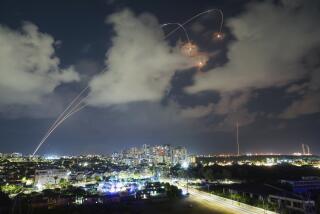Wise Decision on Missile Defense
- Share via
President Clinton has acted responsibly in leaving to his successor the decision on when or whether to deploy a missile defense system intended to protect America’s 50 states against a small-scale attack. As the president noted, the technology to assure that an antimissile system would be effective remains unproven and the diplomatic problems that deployment would raise remain unresolved.
U.S. officials had set 2005 as the year for deploying the first phase of a national missile defense system--known as NMD--a date based on a worst-case intelligence estimate of North Korea’s progress in missile development. But so far as can be seen, Pyongyang’s long-range missile program hasn’t advanced significantly. American security won’t be diminished by delaying a decision on deploying NMD.
Initial tests of the system haven’t been encouraging, in part because of the precision demanded. What’s required is that a rocket-launched interceptor, called a kill vehicle, directly strike an incoming warhead. It is the impact alone, not any explosives on the kill vehicle, that does the job, so coming close doesn’t count. It’s also crucial that the kill vehicle’s sensors differentiate between a real warhead and decoys. Russia and China both know all about decoys, information they could pass on to North Korea, Iraq, Iran or other states that might someday pose a missile threat to the United States.
An ability to tell what’s a decoy has yet to be shown by NMD. Philip E. Coyle III, the Pentagon’s top testing official, recently told aides that tests involving decoy targets aren’t planned before September 2002. His report, obtained by Bloomberg News, said a system should be shown to be “effective under realistic combat conditions, against realistic threats and countermeasures” before it’s deployed. That, and not political considerations, should be a key determinant of when or whether to proceed with NMD.
President Clinton’s successor must also weigh the international consequences of proceeding with NMD. Russia and China say the system would be destabilizing and bring on a new arms race. Conservative proponents of NMD wave aside these concerns, though the prospect of a costly revival of arms competition deserves far more than casual dismissal. No less serious is the opposition to NMD voiced by all of Washington’s European allies, including those who would have to provide sites for special ground-based radar and communications systems. NMD is not, in short, a go-it-alone project.
Clinton did the right thing in deferring a decision on building an antimissile system. His successor will do the right thing if he insists on proof that the system will work before considering deployment at a projected cost of $60 billion. That means realistic tests under real-world conditions, something the Pentagon is still a long way from providing.
More to Read
Sign up for Essential California
The most important California stories and recommendations in your inbox every morning.
You may occasionally receive promotional content from the Los Angeles Times.










